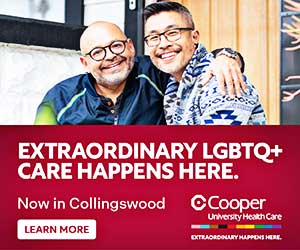Leaders in the local LGBT community came together this week for the first training of the LGBT Complete Count Committee, an ongoing effort to heighten awareness and understanding of the role LGBT individuals will play in the upcoming U. S. Census.
This marks the first year that the city, which organizes Complete Count Committees to reach numerous other minority populations, has launched a committee to represent the LGBT population.
The training, held at the offices of the Delaware Valley Legacy Fund, brought together about 15 local residents to provide them with the tools and information necessary to explain to their respective communities why LGBT participation in the 2010 census is essential.
The Economic Development Committee of the mayor’s LGBT Advisory Board, which was formed last fall, worked in conjunction with Gloria Casarez, the city’s director of LGBT Affairs, and Lanette Swopes, U.S. Census LGBT partnership specialist, to create the committee.
“The census work falls under the Economic Development Committee, and they’ve really taken a strong interest in this issue and worked to move it forward,” Casarez said. “The seeds for this effort really started with them.”
Bill Gehrman, chair of the Economic Development Committee, said the group decided to focus on the census because heightened participation could eventually mean significant economic gains for the city and the LGBT community.
“The census shows the population and the vibrancy of our city, which could mean more federal funds,” he said. “And it can show corporations and businesses what our communities look like and that we have a market for them, which really can only help the city’s economic development.”
The Complete Count Committee’s first initiative came in the fall with the launch of ICountPhilly.com, created in partnership with PhillyGayCalendar.com, which provides basic information about how LGBT people will be counted in the census. The committee also distributed about 5,000 stickers at OutFest that directed LGBTs to visit the site to learn more about the effort.
The community is invited to an information session with Gary Gates, a demographer from the Williams Institute on Sexual Orientation Law and Public Policy and a U.S. Census consultant, from 6-8 p.m. Dec. 7 at the William Way LGBT Community Center, 1315 Spruce St.
Casarez noted the session was spurred by the “questions and frustrations” the committee heard from LGBTs who were unsure how they would be counted in the census.
Same-sex couples were counted in the 2000 Census, although those who indicated they were married were recorded as “unmarried partners,” a policy that will not be followed this year.
The 2008 American Community Survey, a product of the U.S. Census Bureau distributed to a certain percentage of households every year, marked the first time same-sex married couples were officially counted. The survey found an estimated 149,956 same-sex married couples and 414,787 unmarried same-sex couples.
Casarez said there is no question regarding sexual orientation or gender identity on the 10-question document, an item many in the LGBT community is encouraging for in the next census.
“At the end of the day, even though the entire LGBT population will not be counted this time around, it will give us some sense of the number of same-sex couples,” she said.
Gehrman said that during Mayor Nutter’s kickoff event to promote census awareness a few weeks ago, he cited statistics that Philadelphia was well below the state and national average of census participation.
“I was really shocked to hear that,” Gehrman said. “It’s important for everyone to be aware of what the census is, what to expect and, especially for the LGBT community, to understand the truth. Even if they are imperfect truths, the community needs to see the value and importance of the census.”
Casarez said the Complete Count Committee will work in the coming months to create “consistent messaging” and printed materials that will help explain census procedures to the community and also provide feedback to the Census Bureau on the need for expanded measurements of the entire LGBT population.
Beyond its census work, Casarez said the full LGBT Advisory Board, with some 20 members divided into several committees, has met twice this year.
“The original thought was that the full advisory board would meet anywhere from one to four times a year, but it is a big group of really busy people,” she said. “There probably won’t be another big group meeting before the year’s out, but I would like to have them meet more often next year.”
Many of the committees have not met since the summer, Casarez said, although some initiatives have been moving forward.
For instance, Casarez and members of the School District of Philadelphia’s LGBT Advisory Committee, comprised of some members of the LGBT Advisory Board, recently launched an LGBT School Resource Guide and secured a letter from the superintendent to all school principals that reiterates the district’s LGBT-supportive policies.
Casarez recently met with representatives from Children’s Hospital of Philadelphia who are examining issues of sexual health and housing needs of local youth, while city agencies like the Department of Human Services have also undertaken efforts to expand their LGBT services. She said the work already being conducted by these organizations will need to be taken into consideration when the committees ultimately reunite.
“We have the opportunity to plug into existing work that’s already being done, which we’re very eager to team up with other agencies to do,” Casarez said. “There’s a lot of work being done right now, so we don’t necessarily want to reinvent the wheel, but we need to find the right balance.”
Jen Colletta can be reached at [email protected].
